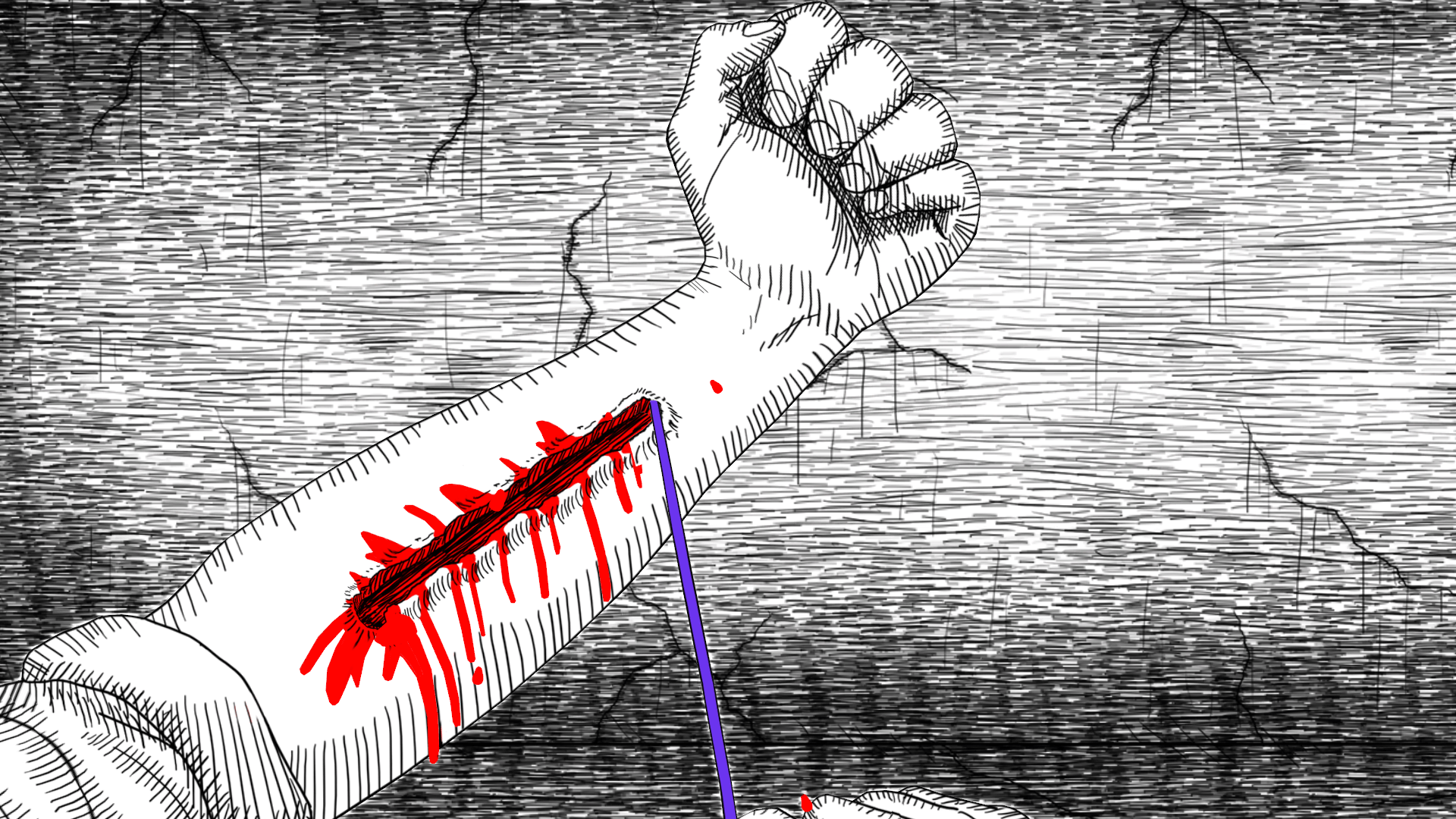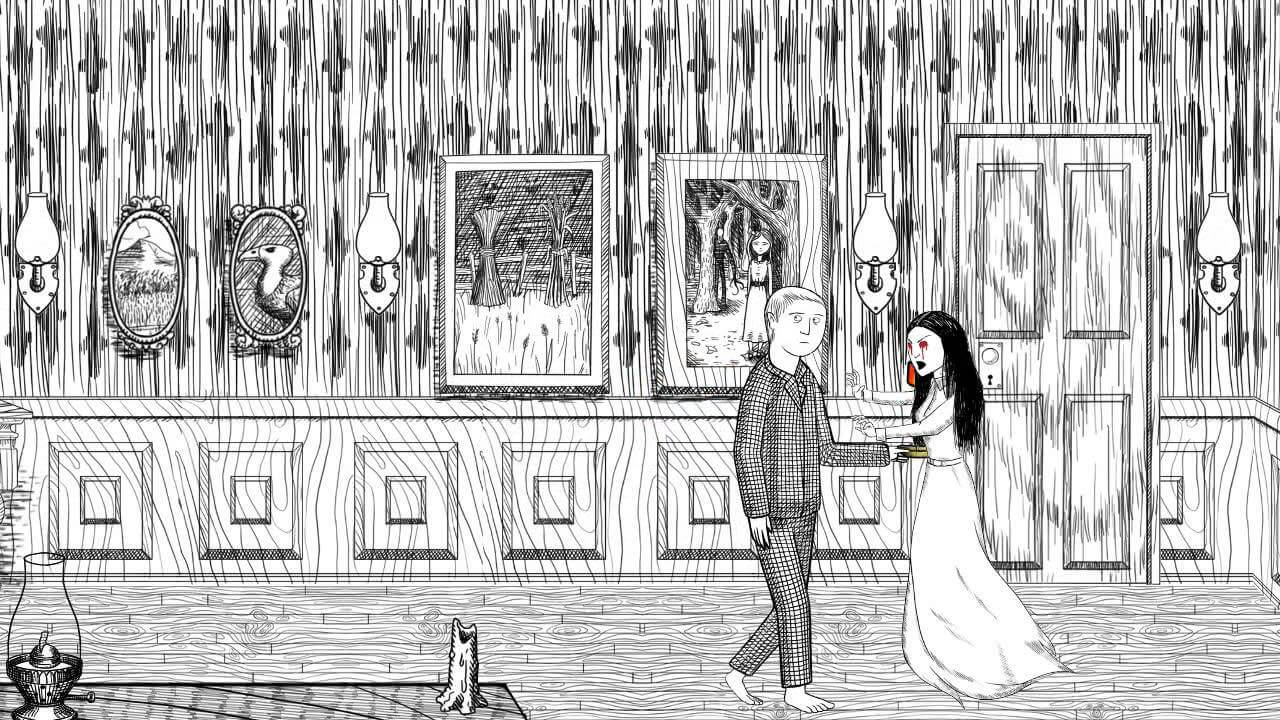Title: Neverending Nightmares
Version Tested: PlayStation 4
Available On: PlayStation Vita, PlayStation 4, PC, Mac, Linux, Ouya
Developer: Infinitap Games
Publisher: Infinitap Games
Genre: Survival Horror
Official Site: infinitapgames.com
Release Date: May 3rd, 2016 (PS4, PS Vita)
Where to Buy: PlayStation Network, Steam, GOG, Ouya Store, Official Site, Humble Store
The original release date of Neverending Nightmares (September, 25th 2014) had the unfortunate coincidence of dropping around the same release window of two triple-A, survival horror games; a shocking rarity in the gaming economy. Those games being The Evil Within and Alien: Isolation. Both received critical and commercial success, largely overshadowing an indie game like Neverending Nightmares; at least for myself. However, like a phoenix rising from its ashes, Neverending Nightmares is back in the limelight for its PS4 and PS Vita release this past week, wisely releasing with little to no competition for a helping of horror.

The story of how Neverending Nightmares came to be is a fascinating one. The game was inspired largely by developer Matt Gilgenbach’s battle with obsessive-compulsive disorder and depression. Neverending Nightmares is meant to be the culmination of his internal struggle, a sort of catharsis for the developer. Gilgenbach was incredibly open with his illness, and you can hear him talk in detail over at his youtube channel (which I highly recommend). Understanding what influenced Neverending Nightmares’ themes, art style, and gameplay is extremely important in setting expectations for the game. The game isn’t meant to be enjoyed in a traditional sense. Gilgenbach makes some very conscious design choices that make for a hard piece of media to digest, but one that does so unflinchingly at times to emphasize its themes.
Players control Thomas, who either can’t seem to wake up from his dreams or is unable to determine nightmare from reality. The game is 2.5D with players navigating Thomas through a handful of locations. You will move through a barrage of seemingly never ending (PUN!) hallways and doors, triggering events that cause Thomas to wake up into a new dream. Along the way, Thomas will encounter enemies and very light puzzles that hinder his progress.
Thomas’s only defense against enemies is to run (extremely slowly) or hide. Running in Neverending Nightmares completely nails the feeling of being in a dream. It feels like you’re wading through quicksand. It’s admittedly frustrating, but I can’t help but feel the effect is intentional. I’ve had dreams where I’ll be hitting someone or something and it feels slowed down as if I’m punching underwater. The game makes running feel like that. Thomas can also run out breath, there’s no stamina meter to monitor, so players have to listen to the frequency of his breathing to determine when he’ll need to stop for a break.
The way the flight response is handled in Neverending Nightmares tries to emphasize the lack of control the player has, as well as boost the tension of a few chase sequences. Should Thomas need to stop to catch his breath with a monster hot on his heels, it almost always means a gruesome end. The slow speed of Thomas, does work thematically for the game, however, it will chip away at most players patience. I’m conflicted because I recognize it’s intended to give the player anxiety, but after an hour of playing the game, it becomes exhausting. This is a result of the initial beauty and intrigue wearing away after the first thirty minutes. Once you’ve gone through the same identical hallways and rooms, all you want to do is get Thomas to the next dream.

Although the rooms and hallways begin to repeat themselves, it’s hard to deny the power of the art style. Looking akin to the kids horror book More Scary Stories To Tell In The Dark, it’s extremely effective in praying off primal fears of the dark, while looking wholly unlike anything else you’ve seen in a video game. It is striking in every sense. The scratched black and white sketches work to amplify the general feeling of unease while playing the game. I loved the small circle of light Thomas’s candle gives off while the rest of the game is engulfed in pencil scratched blackness like a child was scribbling out a drawing. The PS4 touchpad also flickers red with the candle flame, eerily bringing a similar effect to my living room. I also felt that red being the only real consistent use of color works on a higher level conceptually. The blood red juxtaposed with the black and white art of the game pops in a gruesome fashion, enforcing the grizzly self-destructive violence in Neverending Nightmares.
Thomas’s self-destruction is given weight with quality voice acting. It’s hard not to feel empathy when Thomas’s screams, yelps, and groans are all palpable. His voice will quiver in fear and concern while confronting his wife (or sister), injecting humanity into the preceedings. As players explore, malevolent whispers and cracks of thunder add some layers of ambiance to the environment. Piling another dimension onto the atmosphere is the music, which alternates between mechanical groans and somber melodies. Neverending Nightmares sounds great.
Neverending Nightmares never ceases to look or sound like a horrifying storybook brought to life. Unfortunate that it’s reuse of art assets becomes abundantly obvious by the end. One could argue it’s a purposeful design choice, used to amplify a dreamlike sameness to the world, or disorient the players sense of location. If that’s the case it’s effective, but it becomes a bore to explore. What’s worse about the repeating environments is there’s nothing to really interact with, albeit a picture or two you can look at. What little puzzles there are, they’re simply solved. Whether it’s figuring out how to slip by an enemy or finding an ax to chop down a blocked path, the puzzles leave a lot to be desired. It’s not that they needed to be especially cerebral, but anything to break up the pacing of the game would have been welcomed. The combination of the repetitive exploration, lack of variety, and Thomas’s slow movement works to create a gameplay experience that really tries your patience. Yet, even with my patience pushed to the limit, I was compelled to see the game through. I had to know the same answers Thomas was looking for.

The answers Thomas seeks are given in very visually jarring and grizzly violent cutscenes. The cutscenes are the bookend between the dreams, giving the player light threads of story to push them through to the next chapter. The ending is abrupt, but does all that it needs to do to explain why Thomas is in the emotional distress he’s in. It’s a very human and tragic revelation. Strengthened by the solid delivery of the voice acting. The ending I received was one of three possible endings. It’s at this point you realize some of the dreams have branching paths, depending on which direction you went through them. I found this to be a really cool idea, one that I wish was expanded on. There’s only two paths that branch into new areas. I would have liked to see more gameplay ideas and location variety interspersed in the branching dreams. It would have helped break up some of the visual and gameplay repetition. The repetition is particularly important to note because it feels superfluous even at about a two-hour playthrough, three hours if you go for the other two endings.
Neverending Nightmares is a very interesting game. One that was pushing me away as much as it was pulling me in. I came away feeling very conflicted about the whole experience but ultimately felt the entire package was worth experiencing for the right price. Neverending Nightmares isn’t meant to be a fun game, it isn’t meant to reward your time, or make you feel particularly good. The game succeeds as an experiment in creating anxiety within the player. The design choices, while frustrating and trying of your patience, are uncompromisingly chosen as a metaphor for obsessive-compulsive disorder and depression. If you’re a fan of the horror genre and you’re willing to embrace the purposeful discomfort of Neverending Nightmares, you’ll find your time meaningfully spent.
[embedyt] https://www.youtube.com/watch?v=lLqHUSefBjw[/embedyt]
- Gameplay: 2.5D sidescrolling survival horror and exploration
- Graphics: Striking visuals feels like a horror book brought to life
- Sound: Solid voice acting great ambient noises
- Presentation: The whole package is first class uneasiness
[review]







